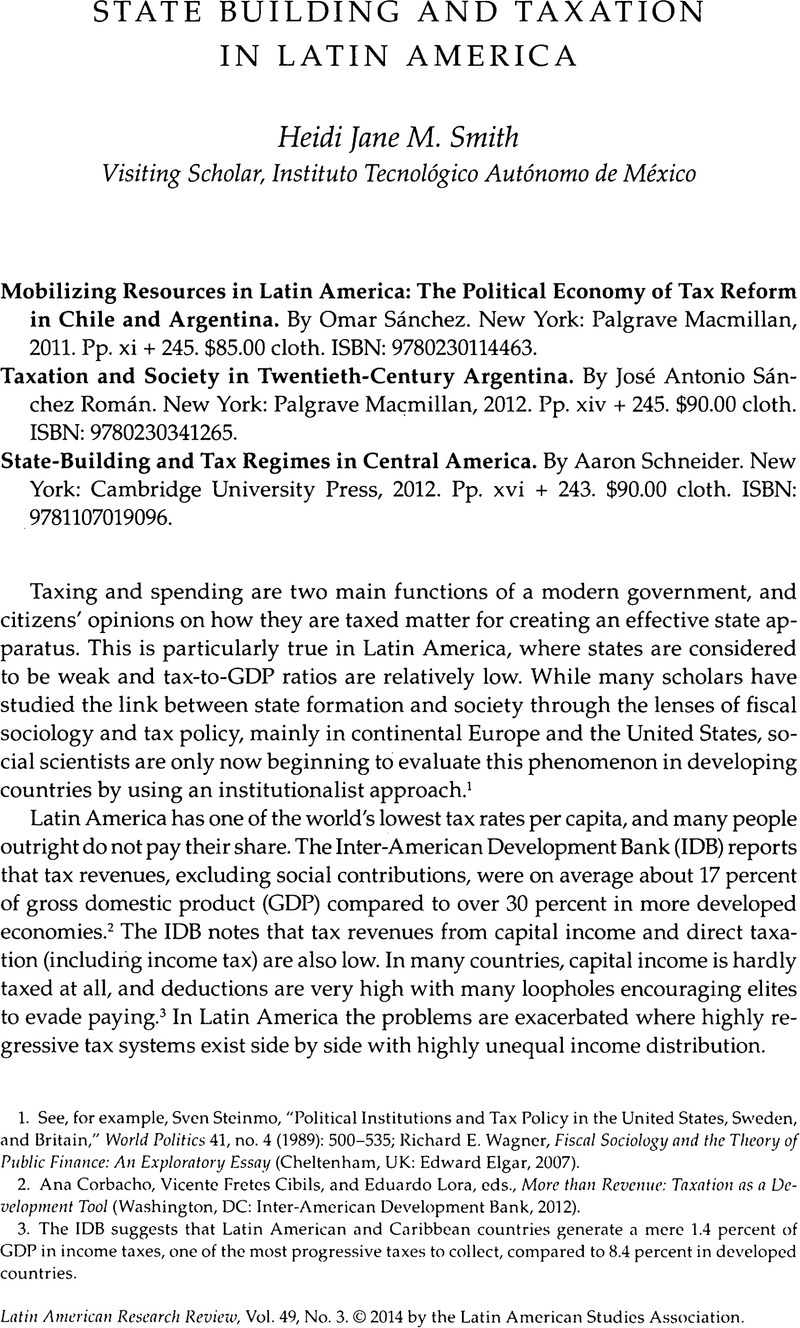No CrossRef data available.
Article contents
STATE BUILDING AND TAXATION IN LATIN AMERICA
Review products
Published online by Cambridge University Press: 05 September 2022
Abstract

- Type
- Review Essays
- Information
- Copyright
- Copyright © 2014 by the University of Texas Press
References
1. See, for example, Sven Steinmo, “Political Institutions and Tax Policy in the United States, Sweden, and Britain,” World Politics 41, no. 4 (1989): 500-535; Richard E. Wagner, Fiscal Sociology and the Theory of Public Finance: An Exploratory Essay (Cheltenham, UK: Edward Elgar, 2007).
2. Ana Corbacho, Vicente Fretes Cibils, and Eduardo Lora, eds., More than Revenue: Taxation as a Development Tool (Washington, DC: Inter-American Development Bank, 2012).
3. The IDB suggests that Latin American and Caribbean countries generate a mere 1.4 percent of GDP in income taxes, one of the most progressive taxes to collect, compared to 8.4 percent in developed countries.
4. These data vary among sources; whereas the IDB reports revenue 17 percent of GDP for the region and as high as 40 percent in Brazil in 2008; the Economist Intelligence Unit reports 23 percent for the region and 36 percent in Brazil in 2008.
5. Herbert A. Simon, Models of Man: Social and Rational; Mathematical Essays on Rational Human Behavior in a Society Setting (New York: Wiley, 1957).
6. Margaret Levi, Of Rule and Revenue, California Series on Social Choice and Political Economy (Berkeley: University of California Press, 1988).
7. The University of Oxford Latin American Economic History Database (OxLAD) can be accessed here: http://www.lac.ox.ac.uk/moxlad-database; and United Nations Economic Commission for Latin America and the Caribbean (ECLAC) tax data may be accessed here: http://estadisticas.cepal.org/.
8. See, for example, Juan Gómez Sabaini, “Evolución y situación tributaria actual en América Latina: Una serie de temas para la discusión,” in Tributación en América Latina: En busca de una nueva agenda de reformas, ed. Oscar Cetrángolo and Juan Carlos Gómez Sabaini, 39-130 (Santiago: ECLAC / United Nations, 2006); Eduardo Lora, “El futuro de los pactos fiscales en América Latina,” Working Paper 650 (Washington, DC: Banco Interamericano de Desarrollo, 2008).
9. Luiz De Mello, “Latin America's Public Finances: Governments in Latin America Have Made Enormous Progress in Improving Their Fiscal Management in Recent Years; but What Are the Next Steps?” OECD Observer, no. 254, March 2006.
10. Jonathan Di John, “The Political Economy of Taxation and Tax Reform in Developing Countries,” Research Paper No. 2006/74, July 2006, United Nations University and World Institute for Development Economic Research, UNU-WIDER.




